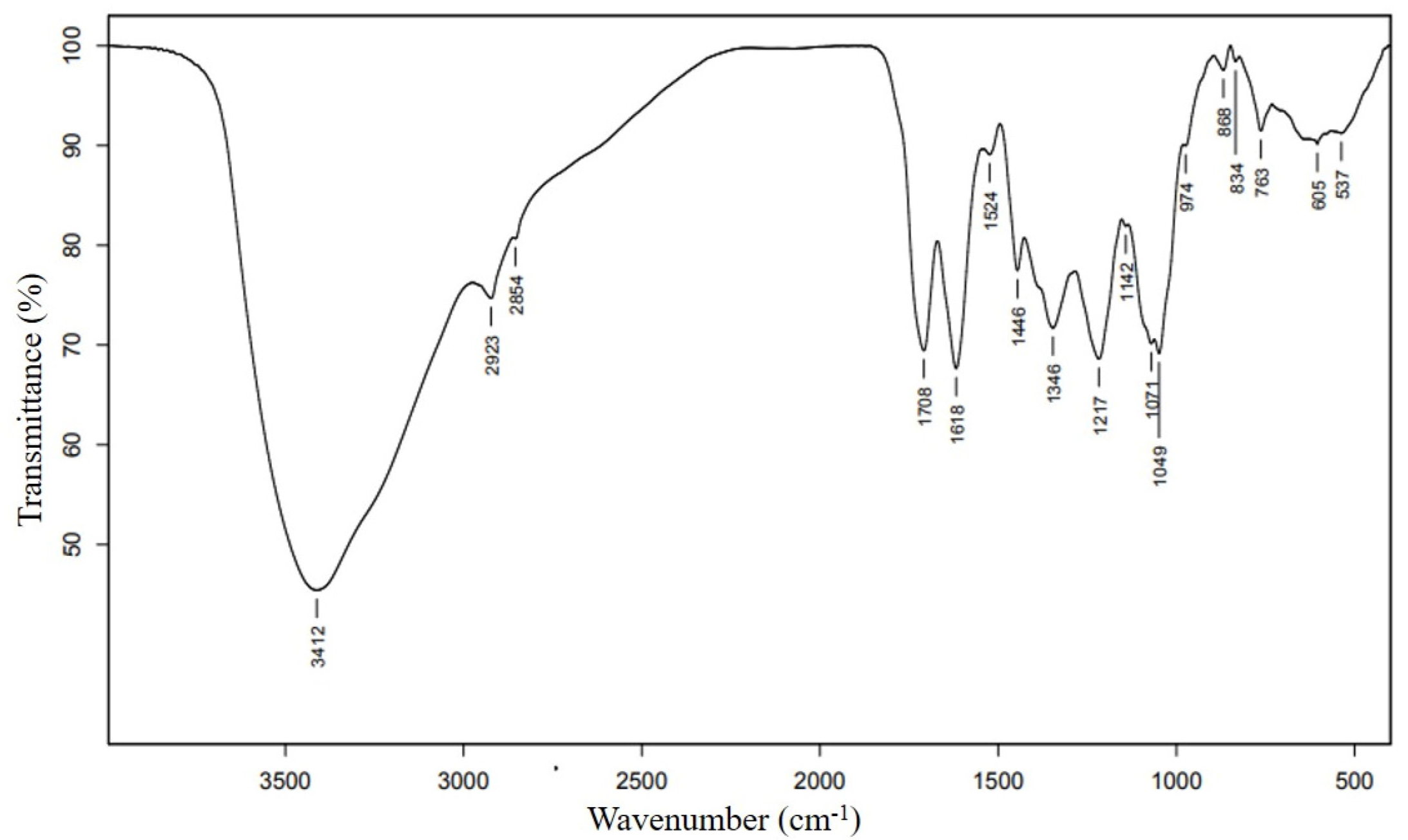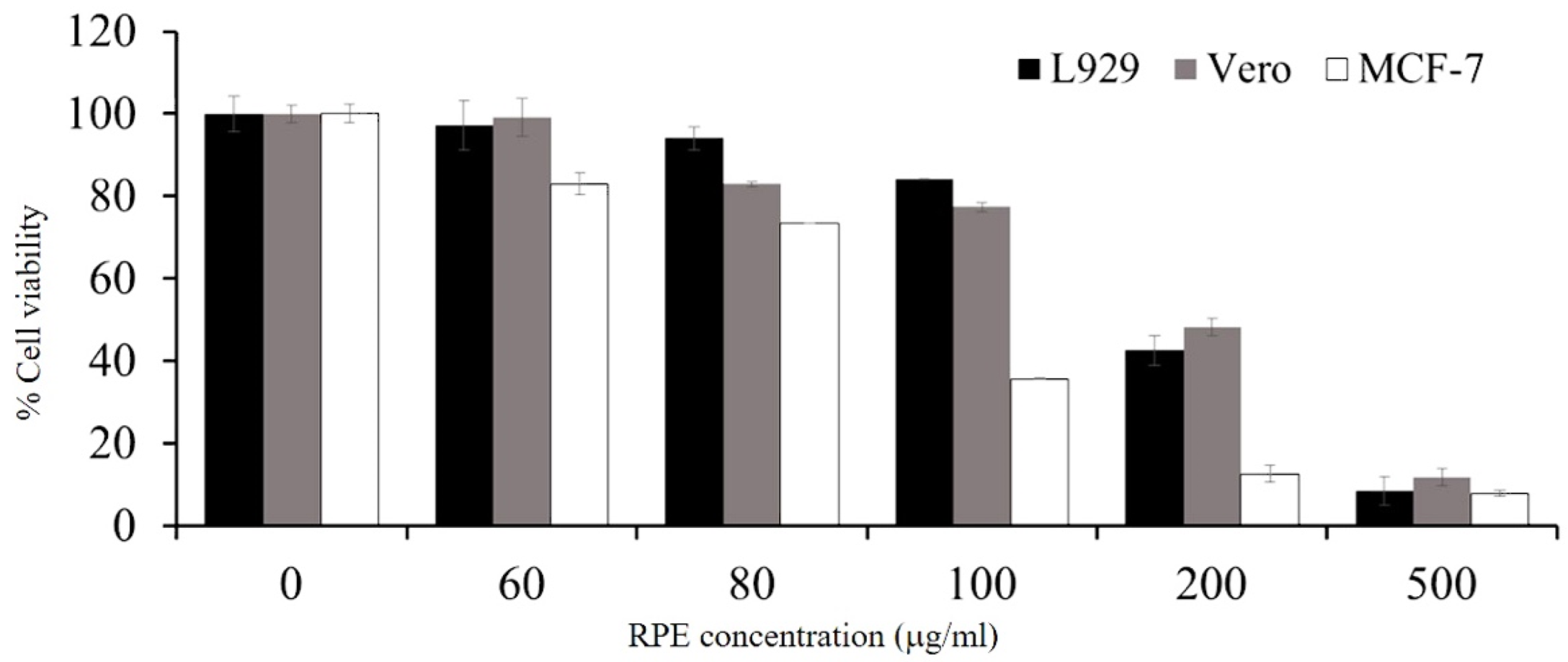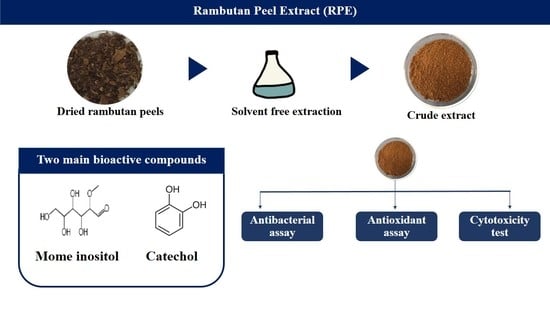Phytochemical Composition and Bioactivities of Aqueous Extract of Rambutan (Nephelium lappaceum L. cv. Rong Rian) Peel
Abstract
:1. Introduction
2. Materials and Methods
2.1. Bacterial Strains
2.2. Chemicals
2.3. Preparation of Dried Rambutan Peels
2.4. Extraction of Rambutan Peel Extract (RPE) by Water Extraction
2.5. GC-MS Analysis
2.6. FT-IR Spectroscopy
2.7. Minimum Inhibitory Concentration (MIC) and Minimum Bactericidal Concentration (MBC) Assays
2.8. Antioxidant Activity Assays
2.8.1. DPPH Assay
2.8.2. ABTS Assay
2.8.3. Scavenging Activity of RPE
2.9. In Vitro Cytotoxicity of RPE
2.9.1. Cell Line Culture
2.9.2. Cytotoxicity Testing
2.10. Statistical Analysis
3. Results
3.1. GC-MS Analysis
3.2. FT-IR Spectroscopy
3.3. Antibacterial Activity of RPE against Food Pathogenic and Spoilage Bacteria
3.4. Antioxidant Activities of the Extract
3.5. Cytotoxicity of RPE
4. Discussion
5. Conclusions
Supplementary Materials
Author Contributions
Funding
Institutional Review Board Statement
Informed Consent Statement
Data Availability Statement
Acknowledgments
Conflicts of Interest
References
- Office of Agricultural Economics (OAE) of Thailand. Available online: https://bit.ly/3K1IYfw (accessed on 20 February 2022).
- Office of Agricultural Economics. Rambutan. Available online: https://bit.ly/3BToCSy (accessed on 26 February 2022).
- Mahmood, K.; Kamilah, H.; Alias, A.K.; Ariffin, F. Nutritional and therapeutic potentials of rambutan fruit (Nephelium lappaceum L.) and the by-products: A review. J. Food Meas. Charact. 2018, 12, 1556–1571. [Google Scholar] [CrossRef]
- Tadtong, S.; Athikomkulchai, S.; Worachanon, P.; Chalongpol, P.; Chaichanachaichan, P.; Sareedenchai, V. Antibacterial activities of rambutan peel extract. J. Health Res. 2011, 25, 35–37. [Google Scholar]
- Phuong, N.N.M.; Le, T.T.; Van Camp, J.; Raes, K. Evaluation of antimicrobial activity of rambutan (Nephelium lappaceum L.) peel extracts. Int. J. Food Microbiol. 2020, 321, 108539. [Google Scholar] [CrossRef] [PubMed]
- Hernandez, C.; Ascacio-Valdes, J.; De la Garza, H.; Wong-Paz, J.; Aguilar, C.N.; Martinez-Avila, G.C.; Castro-Lopez, C.; Aguilera-Carbo, A. Polyphenolic content, in vitro antioxidant activity and chemical composition of extract from Nephelium lappaceum L. (Mexican rambutan) husk. Asian Pac. J. Trop. Med. 2017, 10, 1201–1205. [Google Scholar] [CrossRef]
- Gizaw, Z. Public health risks related to food safety issues in the food market: A systematic literature review. Environ. Health Prev. Med. 2019, 24, 68. [Google Scholar] [CrossRef] [Green Version]
- Chen, X.; Hung, Y.C. Development of a Chlorine Dosing Strategy for Fresh Produce Washing Process to Maintain Microbial Food Safety and Minimize Residual Chlorine. J. Food Sci. 2018, 83, 1701–1706. [Google Scholar] [CrossRef]
- Cowan, M.M. Plant products as antimicrobial agents. Clin. Microbiol. Rev. 1999, 12, 564–582. [Google Scholar] [CrossRef] [Green Version]
- Thitilertdecha, N.; Teerawutgulrag, A.; Rakariyatham, N. Antioxidant and antibacterial activities of Nephelium lappaceum L. extracts. LWT-Food Sci. Technol. 2008, 41, 2029–2035. [Google Scholar] [CrossRef]
- Bagchi, K.; Puri, S. Free radicals and antioxidants in health and disease: A review. EMHJ-East. Mediterr. Health J. 1998, 4, 350–360. [Google Scholar] [CrossRef]
- Tsong, J.L.; Goh, L.P.W.; Gansau, J.A.; How, S.E. Review of Nephelium lappaceum and Nephelium ramboutan-ake: A High Potential Supplement. Molecules 2021, 26, 7500. [Google Scholar] [CrossRef]
- Nik, A.B.; Vazifedoost, M.; Didar, Z.; Hajirostamloo, B. The antioxidant and physicochemical properties of microencapsulated bioactive compounds in Securigera securidaca (L.) seed extract by co-crystallization. Food Qual. Saf. 2019, 3, 243–250. [Google Scholar] [CrossRef]
- Arulmozhi, P.; Vijayakumar, S.; Kumar, T. Phytochemical analysis and antimicrobial activity of some medicinal plants against selected pathogenic microorganisms. Microb. Pathog. 2018, 123, 219–226. [Google Scholar] [CrossRef] [PubMed]
- CLSI. Methods for Antimicrobial Dilution and Disk Susceptibility Testing of Infrequently Isolated or Fastidious Bacteria. In CLSI Guideline M45, 3rd ed.; Clinical and Laboratory Standard Institute: Wayne, PA, USA, 2015. [Google Scholar]
- Jitpakdee, J.; Kantachote, D.; Kanzaki, H.; Nitoda, T. Selected probiotic lactic acid bacteria isolated from fermented foods for functional milk production: Lower cholesterol with more beneficial compounds. LWT 2021, 135, 110061. [Google Scholar] [CrossRef]
- Sriwiriyajan, S.; Ninpesh, T.; Sukpondma, Y.; Nasomyon, T.; Graidist, P. Cytotoxicity screening of plants of genus Piper in breast cancer cell lines. Trop. J. Pharm. Res. 2014, 13, 921–928. [Google Scholar] [CrossRef] [Green Version]
- Monrroy, M.; Araúz, O.; García, J.R. Active compound identification in extracts of N. lappaceum peel and evaluation of antioxidant capacity. J. Chem. 2020, 2020, 4301891. [Google Scholar] [CrossRef] [Green Version]
- Skenderidis, P.; Lampakis, D.; Giavasis, I.; Leontopoulos, S.; Petrotos, K.; Hadjichristodoulou, C.; Tsakalof, A. Chemical properties, fatty-acid composition, and antioxidant activity of goji berry (Lycium barbarum L. and Lycium chinense Mill.) fruits. Antioxidants 2019, 8, 60. [Google Scholar] [CrossRef] [Green Version]
- Goudarzi, M.; Mir, N.; Mousavi-Kamazani, M.; Bagheri, S.; Salavati-Niasari, M. Biosynthesis and characterization of silver nanoparticles prepared from two novel natural precursors by facile thermal decomposition methods. Sci. Rep. 2016, 6, 1–13. [Google Scholar] [CrossRef]
- Zhuang, J.; Li, M.; Pu, Y.; Ragauskas, A.J.; Yoo, C.G. Observation of potential contaminants in processed biomass using fourier transform infrared spectroscopy. Appl. Sci. 2020, 10, 4345. [Google Scholar] [CrossRef]
- Nandiyanto, A.B.D.; Oktiani, R.; Ragadhita, R. How to read and interpret FTIR spectroscope of organic material. Indones. J. Sci. Technol. 2019, 4, 97–118. [Google Scholar] [CrossRef]
- Chen, R.; Jin, C.; Tong, Z.; Lu, J.; Tan, L.; Tian, L.; Chang, Q. Optimization extraction, characterization and antioxidant activities of pectic polysaccharide from tangerine peels. Carbohydr. Polym. 2016, 136, 187–197. [Google Scholar] [CrossRef]
- Chakraborty, B.; Mishra, D.; Hazarika, B.; Hazarika, T.; Ghosh, S. Chapter 29 Rambutan (Nephelium lapspaceum). In Breeding of Underutilized Fruit Crops, 1st ed.; Ghosh, S.N., Ed.; JAYA Publishing House: New Delhi, India, 2015; pp. 425–439. [Google Scholar]
- Thitilertdecha, N.; Rakariyatham, N. Phenolic content and free radical scavenging activities in rambutan during fruit maturation. Sci. Hortic. 2011, 129, 247–252. [Google Scholar] [CrossRef]
- Aziz, H.A.; Rahmat, N.S.; Alazaiza, M.Y.D. The Potential Use of Nephelium lappaceum Seed as Coagulant-Coagulant Aid in the Treatment of Semi-Aerobic Landfill Leachate. Int. J. Environ. Res. Public Health 2022, 19, 420. [Google Scholar] [CrossRef] [PubMed]
- Rakariyatham, K.; Zhou, D.; Rakariyatham, N.; Shahidi, F. Sapindaceae (Dimocarpus longan and Nephelium lappaceum) seed and peel by-products: Potential sources for phenolic compounds and use as functional ingredients in food and health applications. J. Funct. Foods 2020, 67, 103846. [Google Scholar] [CrossRef]
- Al-Qahtani, H.; Alfarhan, A.H.; Al-Othman, Z.M. Changes in chemical composition of Zilla spinosa Forssk. medicinal plants grown in Saudi Arabia in response to spatial and seasonal variations. Saudi J. Biol. Sci. 2020, 27, 2756–2769. [Google Scholar] [CrossRef]
- Mathi, P.; Nikhil, K.; Das, S.; Roy, P.; Bokka, V.R.; Botlagunta, M. Evaluation of in vitro anticancer activity and GC-MS analysis from leaf Sophora interrupta Bedd. Int. J. Pharm. Pharm. Sci. 2015, 7, 303–308. [Google Scholar]
- Kocaçalışkan, I.; Talan, I.; Terzi, I. Antimicrobial activity of catechol and pyrogallol as allelochemicals. Z. Naturforsch. C 2006, 61, 639–642. [Google Scholar] [CrossRef]
- Justino, G.C.; Correia, C.F.; Mira, L.; Borges dos Santos, R.M.; Martinho Simões, J.A.; Silva, A.M.; Santos, C.; Gigante, B. Antioxidant activity of a catechol derived from abietic acid. J. Agric. Food Chem. 2006, 54, 342–348. [Google Scholar] [CrossRef]
- Shehata, M.G.; Awad, T.S.; Asker, D.; El Sohaimy, S.A.; Abd El-Aziz, N.M.; Youssef, M.M. Antioxidant and antimicrobial activities and UPLC-ESI-MS/MS polyphenolic profile of sweet orange peel extracts. Curr. Res. Food Sci. 2021, 4, 326–335. [Google Scholar] [CrossRef]
- Oskoueian, E.; Abdullah, N.; Saad, W.Z.; Omar, A.R.; Ahmad, S.; Kuan, W.B.; Zolkifli, N.A.; Hendra, R.; Ho, Y.W. Antioxidant, anti-inflammatory and anticancer activities of methanolic extracts from Jatropha curcas Linn. J. Med. Plant Res. 2011, 5, 49–57. [Google Scholar]
- Vijayakumar, K.; Ramanathan, T. Musa acuminata and its bioactive metabolite 5-Hydroxymethylfurfural mitigates quorum sensing (las and rhl) mediated biofilm and virulence production of nosocomial pathogen Pseudomonas aeruginosa in vitro. J. Ethnopharmacol. 2020, 246, 112242. [Google Scholar] [CrossRef]
- Melgarejo-Sánchez, P.; Núñez-Gómez, D.; Martínez-Nicolás, J.J.; Hernández, F.; Legua, P.; Melgarejo, P. Pomegranate variety and pomegranate plant part, relevance from bioactive point of view: A review. Bioresour. Bioprocess. 2021, 8, 1–29. [Google Scholar] [CrossRef]
- Li, M.-M.; Wu, L.-Y.; Zhao, T.; Xiong, L.; Huang, X.; Liu, Z.-H.; Fan, X.-L.; Xiao, C.-R.; Gao, Y.; Ma, Y.-B. The protective role of 5-HMF against hypoxic injury. Cell Stress Chaperones 2011, 16, 267–273. [Google Scholar] [CrossRef] [Green Version]
- Ali, M.R.; Yong, M.J.; Gyawali, R.; Mosaddik, A.; Ryu, Y.C.; Cho, S.K. Mango (Mangifera indica L.) peel extracts inhibit proliferation of HeLa human cervical carcinoma cell via induction of apoptosis. J. Korean Soc. Appl. Biol. Chem. 2012, 55, 397–405. [Google Scholar] [CrossRef]
- Ryssel, H.; Kloeters, O.; Germann, G.; Schäfer, T.; Wiedemann, G.; Oehlbauer, M. The antimicrobial effect of acetic acid—An alternative to common local antiseptics? Burns 2009, 35, 695–700. [Google Scholar] [CrossRef]
- Naksing, T.; Teeka, J.; Rattanavichai, W.; Pongthai, P.; Kaewpa, D.; Areesirisuk, A. Determination of bioactive compounds, antimicrobial activity, and the phytochemistry of the organic banana peel in Thailand. J. Biosci. 2021, 37, 1981–3163. [Google Scholar] [CrossRef]
- Asghar, A.; Tan, Y.C.; Zahoor, M.; Zainal Abidin, S.A.; Yow, Y.-Y.; Khan, E.; Lahiri, C. A scaffolded approach to unearth potential antibacterial components from epicarp of Malaysian Nephelium lappaceum L. Sci. Rep. 2021, 11, 1–15. [Google Scholar]
- Tahir, T.; Ashfaq, M.; Saleem, M.; Rafiq, M.; Shahzad, M.I.; Kotwica-Mojzych, K.; Mojzych, M. Pyridine Scaffolds, Phenols and Derivatives of Azo Moiety: Current Therapeutic Perspectives. Molecules 2021, 26, 4872. [Google Scholar] [CrossRef] [PubMed]
- Dembitsky, V.M.; Poovarodom, S.; Leontowicz, H.; Leontowicz, M.; Vearasilp, S.; Trakhtenberg, S.; Gorinstein, S. The multiple nutrition properties of some exotic fruits: Biological activity and active metabolites. Int. Food Res. J. 2011, 44, 1671–1701. [Google Scholar] [CrossRef]
- Njeru, S.N.; Obonyo, M.A.; Nyambati, S.O.; Ngari, S.M. Antimicrobial and cytotoxicity properties of the crude extracts and fractions of Premna resinosa (Hochst.) Schauer (Compositae): Kenyan traditional medicinal plant. BMC Complement. Altern. Med. 2015, 15, 295. [Google Scholar] [CrossRef] [Green Version]
- Chen, W.-C.; Wang, S.-W.; Li, C.-W.; Lin, H.-R.; Yang, C.-S.; Chu, Y.-C.; Lee, T.-H.; Chen, J.-J. Comparison of various solvent extracts and major bioactive components from Portulaca oleracea for antioxidant, Anti-Tyrosinase, and Anti-α-Glucosidase Activities. Antioxidants 2022, 11, 398. [Google Scholar] [CrossRef]
- Koleva, I.I.; Van Beek, T.A.; Linssen, J.P.; de Groot, A.; Evstatieva, L.N. Screening of plant extracts for antioxidant activity: A comparative study on three testing methods. Phytochem. Anal. Int. J. Plant Chem. Biochem. Tech. 2002, 13, 8–17. [Google Scholar] [CrossRef] [PubMed]
- Proestos, C.; Lytoudi, K.; Mavromelanidou, O.K.; Zoumpoulakis, P.; Sinanoglou, V.J. Antioxidant capacity of selected plant extracts and their essential oils. Antioxidants 2013, 2, 11–22. [Google Scholar] [CrossRef] [PubMed]
- Shah, P.; Modi, H. Comparative study of DPPH, ABTS and FRAP assays for determination of antioxidant activity. Int. J. Res. Appl. Sci. Eng. Technol. 2015, 3, 636–641. [Google Scholar]
- Bernini, R.; Barontini, M.; Cis, V.; Carastro, I.; Tofani, D.; Chiodo, R.A.; Lupattelli, P.; Incerpi, S. Synthesis and Evaluation of the Antioxidant Activity of Lipophilic Phenethyl Trifluoroacetate Esters by In Vitro ABTS, DPPH and in Cell-Culture DCF Assays. Molecules 2018, 23, 208. [Google Scholar] [CrossRef] [Green Version]
- Sun, L.; Zhang, H.; Zhuang, Y. Preparation of free, soluble conjugate, and insoluble-bound phenolic compounds from peels of rambutan (Nephelium lappaceum) and evaluation of antioxidant activities in vitro. J. Food Sci. 2012, 77, C198–C204. [Google Scholar] [CrossRef]
- Thitilertdecha, N.; Teerawutgulrag, A.; Kilburn, J.D.; Rakariyatham, N. Identification of major phenolic compounds from Nephelium lappaceum L. and their antioxidant activities. Molecules 2010, 15, 1453–1465. [Google Scholar] [CrossRef] [Green Version]
- Dai, J.; Mumper, R.J. Plant phenolics: Extraction, analysis and their antioxidant and anticancer properties. Molecules 2010, 15, 7313–7352. [Google Scholar] [CrossRef]
- Okonogi, S.; Duangrat, C.; Anuchpreeda, S.; Tachakittirungrod, S.; Chowwanapoonpohn, S. Comparison of antioxidant capacities and cytotoxicities of certain fruit peels. Food Chem. 2007, 103, 839–846. [Google Scholar] [CrossRef]
- Geran, R.; Greenberg, N.; Macdonald, M.; Schumacher, A.; Abbott, B. Protocols for screening chemical agents and natural products against animal tumors and other biological systems. Cancer Chemother. Rep. 1972, 3, 17–19. [Google Scholar]
- Hernández-Hernández, C.; Aguilar, C.; Rodríguez-Herrera, R.; Flores-Gallegos, A.; Morlett-Chávez, J.; Govea-Salas, M.; Ascacio-Valdés, J. Rambutan (Nephelium lappaceum L.): Nutritional and functional properties. Trends Food Sci. Technol. 2019, 85, 201–210. [Google Scholar] [CrossRef]


| No. | Name of Compound | Formula | Amount (mg/g of Dry Peel) | Retention Time | Match Factor |
|---|---|---|---|---|---|
| 1 | Mome Inositol | C7H14O6 | 35.99 | 56.7432 | 87.8 |
| 2 | Catechol (1,2-benzenediol) | C6H6O2 | 29.37 | 45.6479 | 96.1 |
| 3 | 5-Hydroxymethylfurfural | C6H6O3 | 5.69 | 41.5651 | 94.9 |
| 4 | 2-Pentenal, (E)- | C5H8O | 5.22 | 20.9707 | 87.4 |
| 5 | Acetic acid | C2H4O2 | 3.69 | 15.5889 | 99.0 |
| 6 | 1,2,3-Propanetriol | C3H8O3 | 3.67 | 37.5876 | 96.2 |
| 7 | 2-furan-carboxaldehyde | C5H4O2 | 2.66 | 15.7927 | 96.1 |
| 8 | 2-Cyclopenten-1-one, 2-hydroxy- | C5H6O2 | 2.63 | 24.5133 | 96.0 |
| 9 | 1,2-Diphenylethan-1-ol | C14H14O | 2.63 | 40.2940 | 97.2 |
| 10 | Phenol | C6H6O | 2.40 | 30.6622 | 95.2 |
| Peak Position (cm−1) | Tentative Assignment | Reference |
|---|---|---|
| 3412 | O–H stretching (hydroxyl) | [18,19] |
| 2923, 2854 | C–H stretching (alkyl) | [18,19] |
| 1708 | C=O stretching (carboxyl, aldehyde, ketone, ester) | [18,19] |
| 1618 | C–O stretching | [20] |
| 1524 | C–C (aromatic ring) | [21] |
| 1446 | C–C (aromatic ring) | [18] |
| 1346 | C–H bending (alkyl) | [18,20,22] |
| 1217 | O–H bending (hydroxyl) | [18,19] |
| 1142 | C–O stretching | [21] |
| 1071 | O–H bending (hydroxyl) | [19] |
| 1049 | C–O stretching | [18] |
| 974 | Carbohydrate | [23] |
| 868 | Glycosidic linkage | [19] |
| 834 | Carbohydrate | [19,23] |
| 763 | =CH bending | [18] |
| 605 | Unknown | |
| 537 | Unknown |
| Bacteria | MIC (µg/mL) | MBC (µg/mL) | MBC/MIC Ratio |
|---|---|---|---|
| Gram-positive bacteria | |||
| Bacillus subtilis PSU4655 | 8192 | 16,384 | 2 |
| Bacillus cereus PSU3874 | 1024 | 2048 | 2 |
| Staphylococcus aureus ATCC25923 | 2048 | >16,384 | ND |
| Gram-negative bacteria | |||
| Vibrio cholerae PSU6072 | 2048 | 8192 | 4 |
| Vibrio parahaemolyticus ATCC17802 | 2048 | >16,384 | ND |
| Salmonella sp. PSU411 | >16,384 | >16,384 | ND |
| Escherichia coli ATCC25922 | >16,384 | >16,384 | ND |
| Pseudomonas aeruginosa ATCC27853 | 8192 | 16,384 | 2 |
| Pseudomonas fluorescens PSU6074 | 8192 | 16,384 | 2 |
| Samples | Antioxidant Activity | |
|---|---|---|
| DPPH IC50 a (µg/mL) | ABTS IC50 (µg/mL) | |
| RPE | 561.53 ± 6.30 * | 494.25 ± 6.35 * |
| Trolox | 30.38 ± 0.56 | 27.37 ± 0.15 |
Publisher’s Note: MDPI stays neutral with regard to jurisdictional claims in published maps and institutional affiliations. |
© 2022 by the authors. Licensee MDPI, Basel, Switzerland. This article is an open access article distributed under the terms and conditions of the Creative Commons Attribution (CC BY) license (https://creativecommons.org/licenses/by/4.0/).
Share and Cite
Jantapaso, H.; Mittraparp-arthorn, P. Phytochemical Composition and Bioactivities of Aqueous Extract of Rambutan (Nephelium lappaceum L. cv. Rong Rian) Peel. Antioxidants 2022, 11, 956. https://doi.org/10.3390/antiox11050956
Jantapaso H, Mittraparp-arthorn P. Phytochemical Composition and Bioactivities of Aqueous Extract of Rambutan (Nephelium lappaceum L. cv. Rong Rian) Peel. Antioxidants. 2022; 11(5):956. https://doi.org/10.3390/antiox11050956
Chicago/Turabian StyleJantapaso, Husanai, and Pimonsri Mittraparp-arthorn. 2022. "Phytochemical Composition and Bioactivities of Aqueous Extract of Rambutan (Nephelium lappaceum L. cv. Rong Rian) Peel" Antioxidants 11, no. 5: 956. https://doi.org/10.3390/antiox11050956
APA StyleJantapaso, H., & Mittraparp-arthorn, P. (2022). Phytochemical Composition and Bioactivities of Aqueous Extract of Rambutan (Nephelium lappaceum L. cv. Rong Rian) Peel. Antioxidants, 11(5), 956. https://doi.org/10.3390/antiox11050956








